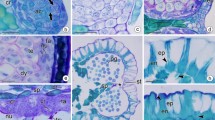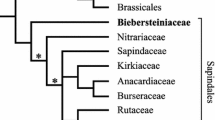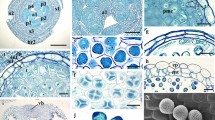Abstract
The family Staphyleaceae, which was recently reorganized into the two genera Staphylea and Dalrympelea based on molecular phylogenetic analyses, is sister to a clade of Crossosomataceae, Guamatelaceae, and Stachyuraceae in the order Crossosomatales. In contrast to Crossosomataceae and Stachyuraceae, the embryology of Staphyleaceae has been scarcely studied. We carried out a literature survey and examined three additional species of each genus in order to better understand the evolution of the embryological characters in the family. Characters were nearly identical across examined species. Staphyleaceae shared most characters of nucellus, megagametophyte, and integuments with Stachyuraceae with the exception of several embryological characters. The presence of a nucellar cap was found to be informative and supports the close relationship between Staphyleaceae and Stachyuraceae. We also investigated the evolution of variable characters among Crossosomataceae, Stachyuraceae, and Staphyleaceae. Staphyleaceae species share the presence of a single archesporial cell and absence of an aril as symplesiomorphies. The presence of less than five parietal cells in the nucellus is a possible synapomorphy for the genus Staphylea, while presence of vascular bundles in the testa is a possible synapomorphy for Staphyleaceae. Our observations support the identification of the seed coat as mesotestal. Several variant embryological characters within the family are discussed.





Similar content being viewed by others
References
Angiosperm Phylogeny Group (2003) An update of the Angiosperm Phylogeny Group classification for the orders and families of flowering plants. Bot J Linn Soc 141:399–436. doi:10.1046/j.1095-8339.2003.t01-1-00158.x
Angiosperm Phylogeny Group (2009) An update of the Angiosperm Phylogeny Group classification for the orders and families of flowering plants: APG III. Bot J Linn Soc 161:105–121. doi:10.1111/j.1095-8339.2009.00996.x
Angiosperm Phylogeny Group (2016) An update of the Angiosperm Phylogeny Group classification for the orders and families of flowering plants: APG IV. Bot J Linn Soc 181:1–20. doi:10.1111/boj.12385
Bentham G, Hooker JD (1867) Genera plantarum, I. Reeve, London
Bessey CE (1915) The phylogenetic taxonomy of flowering plants. Ann Missouri Bot Gard 2:109–164. doi:10.2307/2990030
Brandegee TS (1899) New species of western plants. Bot Gaz 27:444–457. doi:10.1086/327855
Corner EJH (1976) The seeds of dicotyledons. Cambridge University Press, Cambridge
Cronquist A (1981) An integrated system of classification of flowering plants. Columbia University Press, New York
Cronquist A (1988) The evolution and classification of flowering plants, 2nd edn. The New York Botanical Garden, Bronx
Davis GL (1966) Systematic embryology of angiosperms. Wiley, New York
Dickison WC (1986) Floral morphology and anatomy of Staphyleaceae. Bot Gaz 147:312–326. doi:10.1086/337598
Guérin P (1901) Dévéloppment de la graine et en particulier du tégument séminal de quelques Sapindacées. J Bot (Morot) 15:336–362
Huang Y-J, Liu Y-S, Wen J, Quan C (2015) First fossil record of Staphylea L. (Staphyleaceae) from North America, and its biogeographic implications. Pl Syst Evol 301:2203–2218. doi:10.1007/s00606-015-1224-z
Hutchinson J (1926) The families of flowering plants: dicotyledons. Macmillan, London, p 328
Hutchinson J (1973) The families of flowering plants, 3rd edn. Clarendon, Oxford
Johri BM, Ambegaokar KB, Srivastava PS (1992) Comparative embryology of Angiosperms. Springer, Berlin
Kapil RN (1970) Crossosomataceae in symposium comparative embryology of angiosperms. Bull Indian Natl Sci Acad 41:63–68
Kapil RN, Vani RS (1963) Embryology and systematic position of Crossosoma californicum Nutt. Curr Sci 32:493–495
Kimoto Y, Tokuoka T (1999) Embryology and relationships of Stachyurus (Stachyuraceae). Acta Phytotax Geobot 50:187–200
Mason CT Jr (1975) Apacheria chiricahuensis: a new genus and species from Arizona. Madoroño 23:105–108
Mathew CJ, Chaphekar M (1977) Development of female gametophyte and embryogeny in Stachyurus chinensis. Phytomorphology 27:68–79
Matthews ML, Endress PK (2005) Comparative floral structure and systematics in Crossosomatales (Crossosomataceae, Stachyuraceae, Staphyleaceae, Aphloiaceae, Geissolomataceae, Ixerbaceae, Strasburgeriaceae). Bot J Linn Soc 147:1–46. doi:10.1111/j.1095-8339.2005.00347.x
Mauritzon J (1936) Zur Embryologie einiger Parietales-familien. Svensk Bot Tidskr 30:79–113
Mauritzon J (1939) Contribution to the embryology of the orders Rosales and Myrtales. Acta Univ Lund 35:1–121
Mottier DM (1914) Mitosis in the pollen mother-cells of Acer negundo L. and Staphylea trifoliata L. Ann Bot [König & Sims] 28:115–133
Nandi OI, Chase MW, Endress PK (1998) A combined cladistic analysis of angiosperms using rbcL and non-molecular data sets. Ann Missouri Bot Gard 85:137–212. doi:10.2307/2992003
Narayana LL (1960) Embryology of Staphyleaceae. Curr Sci 29:403–404
Netolitzky F (1926) Anatomie der Angiospermen-Samen. In: Linsbauer K (ed) Handbuch Der Pflanzenanatomie, Abt. II, Teil 2, Bd. 10, pp 194–195
Rendle AB (1925) The classification of flowering plants, vol. 2. University Press, Cambridge
Riddle LC (1905) Development of the embryo sac and embryo of Staphylea trifoliata. Ohio Naturalist 5:320–325
Sato Y (1976) Embryological studies on Stachyurus praecox and its variety. Sci Rep Tohoku Univ Fourth Ser Biol 37:131–138
Savolainen V, Chase MW, Hoot SB, Morton CM, Soltis DE, Bayer C, Fay MF, de Bruijn AY, Sulllivan S, Qiu Y-L (2000a) Phylogenetics of flowering plants based on combined analysis of plastid atpB and rbcL sequences. Syst Biol 49:306–362. doi:10.1093/sysbio/49.2.306
Savolainen V, Fay MF, Albach DC, Backlund A, van der Bank M, Cameron KM, Johnson SA, Lledó MD, Pintaud J-C, Powell M, Sheahan MC, Soltis DE, Soltis PS, Weston P, Whitten WM, Wurdack KJ, Chase MW (2000b) Phylogeny of the eudicots: a nearly complete familial analysis based on rbcL gene sequences. Kew Bull 55:257–309. doi:10.2307/4115644
Schmid R, Turner MD (1977) Contrad 70, an effective softner of herbarium material for anatomical study. Taxon 26:551–552. doi:10.2307/1219648
Scholz H (1964) Staphyleaceae. In: Melchior H (ed) A Engler’s Syllabus der Pflanzenfamilien, vol. 3, part 5. Wilhelm Engelmann, Leipzig
Simmons SL (2002) A molecular phylogenetic investigation of the Staphyleaceae (DC.) Lindl.: with implications for its taxonomy and biogeography. PhD Thesis, University of Texas, Austin
Simmons SL (2007) Staphyleaceae. In: Kubitzki K (ed) Flowering plants. Eudicots. The families and genera of vascular plants, IX. Springer, Berlin, pp 440–445
Soltis DE, Mort ME, Soltis PS, Albach DC, Zanis M, Savolainen V, Hahn WH, Hoot SB, Fay MF, Axtell M, Swensen SM, Price LM, Kress WJ, Nixon KC, Farris JS (2000) Angiosperm phylogeny inferred from 18S rDNA, rbcL, and atpB sequences. Bot J Linn Soc 133:381–461. doi:10.1111/j.1095-8339.2000.tb01588.x
Stevens PF (2001 onwards) Angiosperm phylogeny website. Version 12, July 2012 [and more or less continuously updated since]. Available at: http://www.mobot.org/MOBOT/research/APweb/. Accessed 17 Jan 2017
Takhtajan A (1997) Diversity and classification of flowering plants. Columbia University Press, New York
Thorne RF, Scogin R (1978) Forsellesia Greene (Glossopetalon Gray), a third genus in the Crossosomataceae, Rosineae, Rosales. Aliso 9:171–178. doi:10.5642/aliso.19780902.03
Tobe H (1989) The embryology of angiosperms: its broad application to the systematic and evolutionary study. Bot Mag (Tokyo) 102:351–367. doi:10.1007/BF02488572
Tokuoka T (2007) Molecular phylogenetic analysis of Euphorbiaceae sensu stricto based on plastid and nuclear DNA sequences and ovule and seed character evolution. J Pl Res 120:511–522. doi:10.1007/s10265-007-0090-3
Tokuoka T, Tobe H (2001) Ovules and seeds in subfamily Phyllanthoideae (Euphorbiaceae): structure and systematic implications. J Pl Res 114:75–92. doi:10.1007/PL00013970
Tokuoka T, Tobe H (2002) Ovules and seeds in subfamily Euphorbioideae (Euphorbiaceae): structure and systematic implications. J Pl Res 115:361–374. doi:10.1007/s10265-002-0047-5
Tokuoka T, Tobe H (2003) Ovules and seeds in Acalyphoideae (Euphorbiaceae): structure and systematic implications. J Pl Res 116:355–380. doi:10.1007/s10265-003-0116-4
Wettstein R (1935) Handbuch der systematischen Botanik. Franz Deuticke, Wien
Acknowledgement
I am grateful to two anonymous reviewers and Louis P. Ronse De Craene (E) for helpful comments on the manuscript. This study was supported by a Grant-in-Aid for Scientific Research from the Japan Society for the Promotion of Science (25440205).
Author information
Authors and Affiliations
Corresponding author
Ethics declarations
Conflict of interest
The authors declare that they have no conflict of interest.
Additional information
Handling editor: Louis P. Ronse De Craene.
Rights and permissions
About this article
Cite this article
Ishida, T., Tokuoka, T. Embryology and its character evolution in Staphyleaceae. Plant Syst Evol 303, 1317–1329 (2017). https://doi.org/10.1007/s00606-017-1455-2
Received:
Accepted:
Published:
Issue Date:
DOI: https://doi.org/10.1007/s00606-017-1455-2




